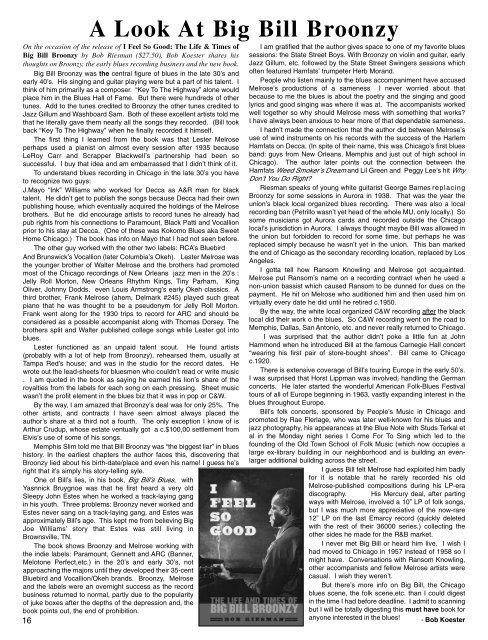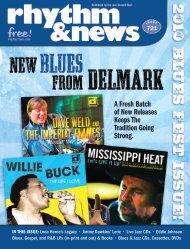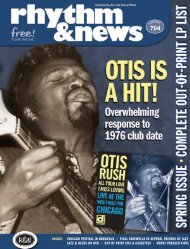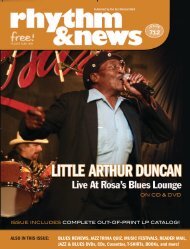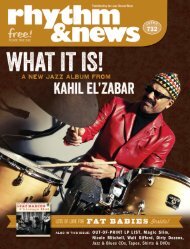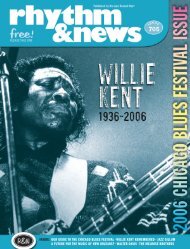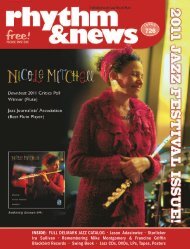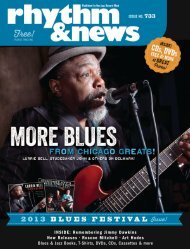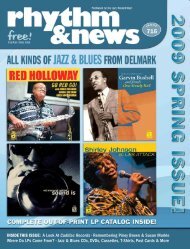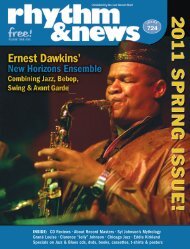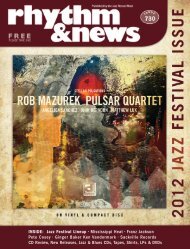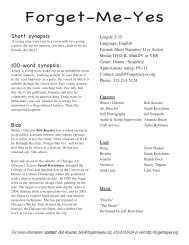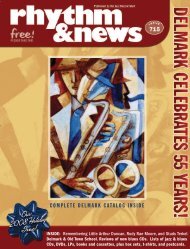INSIDE: DETAILED DELMARK BLUES ... - Delmark Records
INSIDE: DETAILED DELMARK BLUES ... - Delmark Records
INSIDE: DETAILED DELMARK BLUES ... - Delmark Records
You also want an ePaper? Increase the reach of your titles
YUMPU automatically turns print PDFs into web optimized ePapers that Google loves.
A Look At Big Bill Broonzy<br />
On the occasion of the release of I Feel So Good: The Life & Times of<br />
Big Bill Broonzy by Bob Riesman ($27.50), Bob Koester shares his<br />
thoughts on Broonzy, the early blues recording business and the new book.<br />
Big Bill Broonzy was the central figure of blues in the late 30’s and<br />
early 40’s. His singing and guitar playing were but a part of his talent. I<br />
think of him primarily as a composer. “Key To The Highway” alone would<br />
place him in the Blues Hall of Fame. But there were hundreds of other<br />
tunes. Add to the tunes credited to Broonzy the other tunes credited to<br />
Jazz Gillum and Washboard Sam. Both of these excellent artists told me<br />
that he literally gave them nearly all the songs they recorded. (Bill took<br />
back “Key To The Highway” when he finally recorded it himself.<br />
The first thing I learned from the book was that Lester Melrose<br />
perhaps used a pianist on almost every session after 1935 because<br />
LeRoy Carr and Scrapper Blackwell’s partnership had been so<br />
successful. I buy that idea and am embarrassed that I didn’t think of it.<br />
To understand blues recording in Chicago in the late 30’s you have<br />
to recognize two guys:<br />
J.Mayo “Ink” Williams who worked for Decca as A&R man for black<br />
talent. He didn’t get to publish the songs because Decca had their own<br />
publishing house, which eventually acquired the holdings of the Melrose<br />
brothers. But he did encourage artists to record tunes he already had<br />
pub rights from his connections to Paramount, Black Patti and Vocallion<br />
prior to his stay at Decca. (One of these was Kokomo Blues aka Sweet<br />
Home Chicago.) The book has info on Mayo that I had not seen before.<br />
The other guy worked with the other two labels: RCA’s Bluebird<br />
And Brunswick’s Vocallion (later Columbia’s Okeh). Lester Melrose was<br />
the younger brother of Walter Melrose and the brothers had promoted<br />
most of the Chicago recordings of New Orleans jazz men in the 20’s :<br />
Jelly Roll Morton, New Orleans Rhythm Kings, Tiny Parham, King<br />
Oliver, Johnny Dodds, even Louis Armstrong’s early Okeh classics. A<br />
third brother, Frank Melrose (ahem, <strong>Delmark</strong> #245) played such great<br />
piano that he was thought to be a pseudonym for Jelly Roll Morton.<br />
Frank went along for the 1930 trips to record for ARC and should be<br />
considered as a possible accompanist along with Thomas Dorsey. The<br />
brothers split and Walter published college songs while Lester got into<br />
blues.<br />
Lester functioned as an unpaid talent scout. He found artists<br />
(probably with a lot of help from Broonzy), rehearsed them, usually at<br />
Tampa Red’s house; and was in the studio for the record dates. He<br />
wrote out the lead-sheets for bluesmen who couldn’t read or write music<br />
. I am quoted in the book as saying he earned his lion’s share of the<br />
royalties from the labels for each song on each pressing. Sheet music<br />
wasn’t the profit element in the blues biz that it was in pop or C&W.<br />
By the way, I am amazed that Broonzy’s deal was for only 25%. The<br />
other artists, and contracts I have seen almost always placed the<br />
author’s share at a third not a fourth. The only exception I know of is<br />
Arthur Crudup, whose estate ventually got a c.$100,00 settlement from<br />
Elvis’s use of some of his songs.<br />
Memphis Slim told me that Bill Broonzy was “the biggest liar” in blues<br />
history. In the earliest chapters the author faces this, discovering that<br />
Broonzy lied about his birth-date/place and even his name! I guess he’s<br />
right that it’s simply his story-telling syle.<br />
One of Bill’s lies, in his book, Big Bill’s Blues, with<br />
Yasnnick Bruygnoe was that he first heard a very old<br />
Sleepy John Estes when he worked a track-laying gang<br />
in his youth. Three problems: Broonzy never worked and<br />
Estes never sang on a track-laying gang, and Estes was<br />
approximately Bill’s age. This kept me from believing Big<br />
Joe Williams’ story that Estes was still living in<br />
Brownsville, TN.<br />
The book shows Broonzy and Melrose working with<br />
the indie labels: Paramount, Gennett and ARC (Banner,<br />
Melotone Perfect,etc.) in the 20’s and early 30’s, not<br />
approaching the majors until they developed their 35-cent<br />
Bluebird and Vocallion/Okeh brands. Broonzy, Melrose<br />
and the labels were an overnight success as the record<br />
business returned to normal, partly due to the popularity<br />
of juke boxes after the depths of the depression and, the<br />
book points out, the end of prohibition.<br />
16<br />
I am gratified that the author gives space to one of my favorite blues<br />
sessions: the State Street Boys. With Broonzy on violin and guitar, early<br />
Jazz Gillum, etc. followed by the State Street Swingers sessions which<br />
often featured Hamfats’ trumpeter Herb Morand.<br />
People who listen mainly to the blues accompaniment have accused<br />
Melrose’s productions of a sameness I never worried about that<br />
because to me the blues is about the poetry and the singing and good<br />
lyrics and good singing was where it was at. The accompanists worked<br />
well together so why should Melrose mess with something that works?<br />
I have always been anxious to hear more of that dependable sameness.<br />
I hadn’t made the connection that the author did between Melrose’s<br />
use of wind instruments on his records with the success of the Harlem<br />
Hamfats on Decca. (In spite of their name, this was Chicago’s first blues<br />
band: guys from New Orleans, Memphis and just out of high school in<br />
Chicago). The author later points out the connection between the<br />
Hamfats Weed Smoker’s Dream and Lil Green and Peggy Lee’s hit Why<br />
Don’t You Do Right?<br />
Riesman speaks of young white guitarist George Barnes replacing<br />
Broonzy for some sessions in Aurora in 1938. That was the year the<br />
union’s black local organized blues recording. There was also a local<br />
recording ban (Petrillo wasn’t yet head of the whole MU, only locally.) So<br />
some musicians got Aurora cards and recorded outside the Chicago<br />
local’s jurisdiction in Aurora. I always thought maybe Bill was allowed in<br />
the union but forbidden to record for some time, but perhaps he was<br />
replaced simply because he wasn’t yet in the union. This ban marked<br />
the end of Chicago as the secondary recording location, replaced by Los<br />
Angeles.<br />
I gotta tell how Ransom Knowling and Melrose got acquainted.<br />
Melrose put Ransom’s name on a recording contract when he used a<br />
non-union bassist which caused Ransom to be dunned for dues on the<br />
payment. He hit on Melrose who auditioned him and then used him on<br />
virtually every date he did until he retired c.1950.<br />
By the way, the white local organized C&W recording after the black<br />
local did their work o the blues. So C&W recording went on the road to<br />
Memphis, Dallas, San Antonio, etc. and never really returned to Chicago.<br />
I was surprised that the author didn’t poke a little fun at John<br />
Hammond when he introduced Bill at the famous Carnegie Hall concert<br />
“wearing his first pair of store-bought shoes”. Bill came to Chicago<br />
c.1920.<br />
There is extensive coverage of Bill’s touring Europe in the early 50’s.<br />
I was surprised that Horst Lippman was involved, handling the German<br />
concerts. He later started the wonderful American Folk-Blues Festival<br />
tours of all of Europe beginning in 1963, vastly expanding interest in the<br />
blues throughout Europe.<br />
Bill’s folk concerts, sponsored by People’s Music in Chicago and<br />
promoted by Rae Flerlage, who was later well-known for his blues and<br />
jazz photography, his appearances at the Blue Note with Studs Terkal et<br />
al in the Monday night series I Come For To Sing which led to the<br />
founding of the Old Town School of Folk Music (which now occupies a<br />
large ex-library building in our neighborhood and is building an evenlarger<br />
additional building across the street.<br />
I guess Bill felt Melrose had exploited him badly<br />
for it is notable that he rarely recorded his old<br />
Melrose-published compositions during his LP-era<br />
discography. His Mercury deal, after parting<br />
ways with Melrose, involved a 10” LP of folk songs,<br />
but I was much more appreciative of the now-rare<br />
12” LP on the last Emarcy record (quickly deleted<br />
with the rest of their 36000 series.) collecting the<br />
other sides he made for the R&B market.<br />
I never met Big Bill or heard him live. I wish I<br />
had moved to Chicago in 1957 instead of 1958 so I<br />
might have. Conversations with Ransom Knowling,<br />
other accompanists and fellow Melrose artists were<br />
casual. I wish they weren’t.<br />
But there’s more info on Big Bill, the Chicago<br />
blues scene, the folk scene,etc. than I could digest<br />
in the time I had before deadline. I admit to scanning<br />
but I will be totally digesting this must have book for<br />
anyone interested in the blues! - Bob Koester


